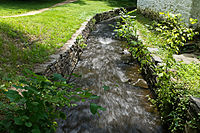
A flume is a human-made channel for water, in the form of an open declined gravity chute whose walls are raised above the surrounding terrain, in contrast to a trench or ditch.[1][2] Flumes are not to be confused with aqueducts, which are built to transport water; flumes use flowing water to transport materials.[citation needed] Flumes route water from a diversion dam or weir to a desired materiel collection location. Flumes are usually made up of wood, metal or concrete.
Many flumes took[when?] the form of wooden troughs elevated on trestles, often following the natural contours of the land. Originating as a part of a mill race, they were later used in the transportation of logs in the logging industry, known as a log flume. They were also extensively used in hydraulic mining and working placer deposits for gold, tin and other heavy minerals.
Etymology[edit]
The term flume comes from the Old French word flum, from the Latin flumen, meaning a river. It was formerly used for a stream, and particularly for the tail of a mill race. It is used in America for a very narrow gorge running between precipitous rocks, with a stream at the bottom, but more frequently is applied to an artificial channel of wood or other material for the diversion of a stream of water from a river for purposes of irrigation, for running a sawmill, or for various processes in the hydraulic method of gold-mining.[3]
Types of flumes[edit]


Millrace[edit]
A diversionary flume is used to transfer water from one body to another, such as between two reservoirs.
Log flume[edit]
Log flumes use the flow of water to carry cut logs and timber downhill, sometimes many miles, to either a sawmill or location for further transport.
Flow measurement flume[edit]
Some varieties of flumes are used in measuring water flow of a larger channel. When used to measure the flow of water in open channels, a flume is defined as a specially shaped, fixed hydraulic structure that under free-flow conditions forces flow to accelerate in such a manner that the flow rate through the flume can be characterized by a level-to-flow relationship as applied to a single head (level) measurement within the flume. Acceleration is accomplished through a convergence of the sidewalls, a change in floor elevation, or a combination of the two.[4]
Flow measurement flumes typically consist of a converging section, a throat section, and a diverging section. Not all sections, however, need to be present. In the case of the Cutthroat flume, the converging section directly joins the diverging section, resulting in a throat section of no length (hence the term "Cutthroat"). Other flumes omit the diverging section (Montana, USGS Portable Parshall, and HS / H / HL flumes).[5]
Flumes offer distinct advantages over sharp-crested weirs:[4]
- For the same control width, the head loss for a flume is about one-fourth of that needed to operate a sharp-crested weir
- The velocity of approach is part of the calibration equations for flumes
- Unauthorized altering of the dimensions of constructed flumes is difficult (and therefore unlikely)
- Most flume styles readily allow for the passage of sedimentation and floating debris – reducing the time and effort associated with maintaining a flume installation
Styles of flow measurement flumes include: Cutthroat, HS / H / HL-type, Khafagi, Montana, RBC, Parshall, Palmer-Bowlus, Trapezoidal, and Venturi Flume.
Flow measurement flumes can be installed in earthen channels, concrete canals, below ground chambers, or factory integrated into Packaged Metering Manholes.[citation needed]
[edit]

In some nineteenth-century canals, a bypass flume diverted water around a lift lock from the level (or pound) above to the level below the lock, so that the level below would have sufficient water.[6]
Recreational flumes[edit]
In competitive swimming, specialized flumes with transparent sides are often employed by coaches to analyze a swimmer's technique. The speed of the flow is variable to accommodate the full spectrum of swimming styles and ability.
Gallery[edit]
-
Measuring flume in the UK
-
Flume outflow
-
A temporary flume in New South Wales
See also[edit]
References[edit]
- ^ Koester, Frank (1909). Hydroelectric Developments and Engineering. New York: D. Van Nonstrand. pp. 40–45.
- ^ Guidelines for Identifying, Evaluating and Registering Historic Mining Sites. Washington, D.C.: National Park Service, U.S. Department of the Interior. 1997.
- ^ One or more of the preceding sentences incorporates text from a publication now in the public domain: Chisholm, Hugh, ed. (1911). "Flume". Encyclopædia Britannica. Vol. 10 (11th ed.). Cambridge University Press. pp. 574–575.
- ^ a b Flumes, Openchannelflow.com
- ^ Sections of a Flume - Their Location and Function, Openchannelflow.com
- ^ Kytle, Elizabeth (1983). Home on the Canal. Cabin John, MD: Seven Locks Press. ISBN 978-080185328-9. p. 270
Further reading[edit]
- http://www.openchannelflow.com/blog/article/sections-of-a-flume-their-location-and-function Sections of a Flume - Their Location and Function
- http://www.openchannelflow.com/blog/article/anatomy-of-a-flume Anatomy of a Flume
- Clemmens, Albert (2010). Water Measurement with Flumes and Weirs. ISBN 978-1887201544.
- Akers, Peter (1978). Weirs and Flumes for Flow Measurement. ISBN 978-0471996378.


